by Tracey T. Flores
I think about my city and all the changes that it’s been through. And all the changes that will come. But I know that here in our little house, there are things that will always be the same. ~from My Papi has a Motorcycle by Isabel Quintero
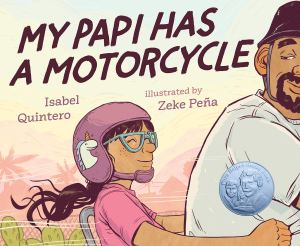 My Papi Has a Motorcycle, written by Isabel Quintero and illustrated by Zeke Peña, tells the story of young Daisy Ramona, a girl who eagerly awaits her Papi’s return home after a long day at work. When he arrives, Daisy Ramona and her Papi will take a ride through their city on the back of his motorcycle. Their ride takes us on a journey through their changing neighborhood, where we get a glimpse into the places and people that make her community so special. On their ride, Daisy and her Papi pass the local panadería where they buy conchas on Sunday mornings, the post office, and their abuelito’s yellow house (where the food always tastes better). They greet each person they meet with a nod of the head or a wave, letting readers see the closeness of this comunidad. Daisy’s ride with her Papi reminds us that although the world outside their home is changing, the love inside will always stay the same.
My Papi Has a Motorcycle, written by Isabel Quintero and illustrated by Zeke Peña, tells the story of young Daisy Ramona, a girl who eagerly awaits her Papi’s return home after a long day at work. When he arrives, Daisy Ramona and her Papi will take a ride through their city on the back of his motorcycle. Their ride takes us on a journey through their changing neighborhood, where we get a glimpse into the places and people that make her community so special. On their ride, Daisy and her Papi pass the local panadería where they buy conchas on Sunday mornings, the post office, and their abuelito’s yellow house (where the food always tastes better). They greet each person they meet with a nod of the head or a wave, letting readers see the closeness of this comunidad. Daisy’s ride with her Papi reminds us that although the world outside their home is changing, the love inside will always stay the same.
I love this cuento. I have shared it with my 4-year old daughter, Milagros, my graduate students in our family-and-community literacies course, and the mamas that I work alongside and learn from at our partner school. Recently, I revisited this cuento and found healing and comfort in it, like a warm bowl of sopa de fideo.
Currently, when I watch the news, it is easy to feel scared and helpless. The impact of this moment on our familias and comunidades is real and heartbreaking. At times, I have found it difficult to imagine our world after this moment. Will my parents be okay? How will my daughter remember this time? What will our comunidades look like after this moment?
In these questioning moments, these moments of uncertainty, I am finding healing, comfort and strength in the lessons and wisdom of our collective Latinx stories.
In our stories, I feel the deep, unconditional love that is the foundation of our familias.
In our stories, I remember every day moments with my loved ones.
In our stories, I bear witness to the fight of our Nanas and Tatas and the obstacles they have overcome in their lives so that we can thrive.
In our stories, I am gifted our history and the wisdom and lessons of our ancestors we carry with us as tools of resistance, hope and survival.
It is in the telling and retelling of our stories that I remember good times, where I am reminded that although the world outside our homes is changing, there are things like our familial love, the strength of our comunidades, and the fight of our gente that will always stay the same.
I offer more cuentos for you to turn to in this moment. From these cuentos, our cuentos, I hope you find peace, comfort and healing. In addition, I invite you to reflect on and remember the cuentos from your own life, those gifted to you by your elders, and those you share with the younger generations—write them down, record them, create art around them—and never forget them, for they are your strengths.
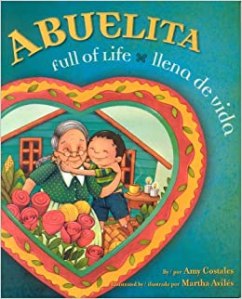 Abuelita Full of Life/Llena de vida
Abuelita Full of Life/Llena de vida
Written by Amy Costales & Illustrated by Martha Aviles
When José goes to the park with Abuelita, they have a walk. At first he misses his bike. But, he likes when Abuelita holds his hand and he can feel the strength that flows beneath her wrinkly skin. She teaches him the names of the trees and the flowers they see on the way. José is amazed by how much he used to miss by rushing by on his bike.
These words capture the loving relationship that José develops with his abuelita when she comes to live with the family. Abuelita brings life, love and pride into their home. In her company, he learns healing remedies, the beauty of English and Spanish, and the deep love of his abuelita. This book reminds me of the wisdom and love that is deeply rooted and embodied in the stories, histories and ways of knowing and being of our Nanas, Tatas, and Abuelitos, and the healing that comes from their presence in our lives.
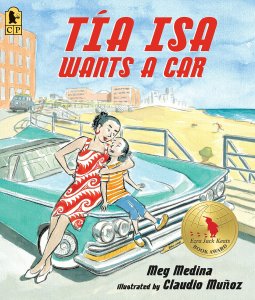 Tía Isa Wants a Car
Tía Isa Wants a Car
Written by Meg Medina & Illustrated By Claudio Muñoz
But Tía Isa is already touching the front seat, big enough for three. She nods when I show her there’s room in the back for more of us, who’ll come soon.
“You’re right mi hija,” she says. “This one will take us all where we want to go.”
Tía Isa shares with the family that she wants to buy a car. Her declaration is met with resistance and ridicule from everyone except her young niece, who imagines all the places this car will take them. Together, Tía Isa and her niece save money to buy a car, one big enough for the entire family to travel to the sea. This cuento truly touches my heart, as I see the faces of all the women in my familia represented in Tía Isa. In this cuento, I remember the strength, determination and creativity of my own mama, nana and tias, and I think about the ways they always speak and manifest their dreams and goals into reality for our entire family. It also reminds me of the strong bond of our familias and the importance of always sticking together.
 In My Family/En mi familia
In My Family/En mi familia
Written & Illustrated By Carmen Lomas Garza
My grandmother is holding a baby. She was holding the babies. And, feeding them, and putting them to sleep.
Through detailed illustrations and short vignettes, artist Carmen Lomas Garza captures the essence of the love for her familia and comunidad that are central to her childhood memories of growing up in Kingsville, Texas. Each illustration features special moments spent with her familia as they gathered for birthday parties, to cook tamales, to make cascarons and dance en el jardín. This book reminds me of the beauty and remedios of our family memories and the joy that is present in our daily lives.
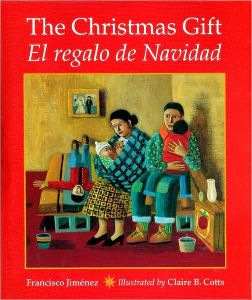 The Christmas Gift/El regalo de la navidad
The Christmas Gift/El regalo de la navidad
Written by Francisco Jiménez and Illustrated by Claire B. Cotts
Most of us have a favorite Christmas story to tell…Like all of my short stories, it is based on an experience I had as a child…It took place in a farm labor tent camp in Corcoran, California.
Author and storyteller Francisco Jiménez (Panchito) shares a Christmas story from his childhood. A few days before Christmas, the family had just moved again to a new camp to find work, money and food was scarce. For Christmas, Panchito was hoping to receive a red ball. When he awoke on Christmas day to find that he did not receive a ball, but a bag of candy, he was disappointed, until he saw the thoughtful gift that his father gave to his mother. I love all books written by Francisco Jiménez, and this book is one of my favorite stories to share with others. In his story, I am reminded of my own family, especially my mother and father, and all the sacrifices they have made and continue to make for our family. It makes me remember the important things in life – our health, our bond as a family and the gift of being together.
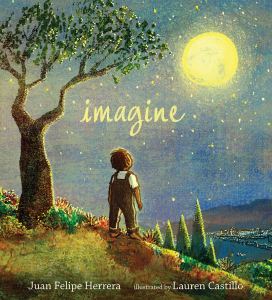 Imagine
Imagine
Written By Juan Felipe Herrera & Illustrated by Lauren Castillo
If I jumped up high into my papi’s army truck and left our village of farmworkers and waved adios to my amiguitos. Imagine.
Poet Juan Felipe Herrera journeys us through his life recounting moments of both triumph and struggle as he continued imagining the future. His words take us from the village where he lived as a small child, to his first day of school in a new country, all the way to the steps of the Library of Congress where he reads his poetry and signs his books with “Poet Laureate of the United States.” The poetry of his experiences that he shares can teach us to always imagine endless possibilities for our lives and our worlds. In his words, I am reminded to always have hope and to never stop being a learner.
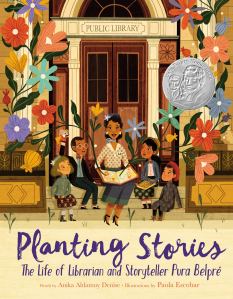 Planting Stories: The Life of Librarian and Storyteller Pura Belpré
Planting Stories: The Life of Librarian and Storyteller Pura Belpré
Written by Anika Aldamuy Denise & Illustrated by Paola Escobar
Now a published author, puppeteer, and storyteller, Pura travels from branch to branch, classroom to classroom, to churches and community centers…planting her story seeds in the hearts and minds of children new to this island who wish to remember la lengua y los colores of home.
This book stories the life of librarian, author, puppeteer, and storyteller Pura Belpré. As the first children’s librarian from Puerto Rico, Pura Belpré planted seeds of cuentos from her homeland, retelling traditional stories, in English and Spanish, to bilingual children and families in New York. Noticing a lack of Spanish books in the library, Pura Belpré wrote and published the traditional stories she orally shared and opened space in the library for the Spanish-speaking comunidad to feel included and at home. This book reminds me of the power of our stories and the necessity of sharing them with others. Also, the importance of writing and recording them for future generations.
 Separate is Never Equal: Sylvia Mendez and Her Family’s Fight for Desegregation
Separate is Never Equal: Sylvia Mendez and Her Family’s Fight for Desegregation
Written and Illustrated by Duncan Tonatiuh
The Mendez family did not give up. Time and time again, Sylvia hear her father talk with coworkers, friends, and other parents. “It’s not fair that our kids have to go to an inferior school,” he said. “It’s not only the building that’s a problem—the teachers at school don’t care about our children’s education. They expect them to drop out by the eighth grade. How will our children succeed and become doctors, lawyers and teachers?”
This book tells the true story of Sylvia Mendez and her parents’ fight to end school segregation in California in the historic Mendez v. Westminster decision. The Mendez decision was reached seven years prior to the Brown V. Board of Education case which dismantled the “separate but equal” doctrine in public education. From this story, we learn about the key role that our familias and comunidades had in the desegregation of our schools, which is often absent from the history we learn in school. In this book, I witness the courage and advocacy of the Mendez family and I am reminded of our proud history and our collective power when we come together.
 Tracey T. Flores is an assistant professor of language and literacy in the Department of Curriculum and Instruction at the University of Texas at Austin. She is a former English Language Development (ELD) and English language arts teacher, working for eight years in K-8 schools throughout Glendale and Phoenix, Arizona. Tracey is the founder of Somos Escritoras/We Are Writers (www.somosescritoras.com), a creative space for Latina girls (grades 6-8) that invites them to write, share and perform stories from their lived experiences using art, theater and writing as a tool for reflection and examination of the worlds. She can be contacted at: tflores@austin.utexas.edu and on Twitter @traceyhabla.
Tracey T. Flores is an assistant professor of language and literacy in the Department of Curriculum and Instruction at the University of Texas at Austin. She is a former English Language Development (ELD) and English language arts teacher, working for eight years in K-8 schools throughout Glendale and Phoenix, Arizona. Tracey is the founder of Somos Escritoras/We Are Writers (www.somosescritoras.com), a creative space for Latina girls (grades 6-8) that invites them to write, share and perform stories from their lived experiences using art, theater and writing as a tool for reflection and examination of the worlds. She can be contacted at: tflores@austin.utexas.edu and on Twitter @traceyhabla.
Don’t miss Tracey’s write-up for Latinxs in Kid Lit about her work with Somos Escritoras!
 Here is the publisher’s description:
Here is the publisher’s description: Q. Who or what inspired you to become a writer?
Q. Who or what inspired you to become a writer? Cindy L. Rodriguez was a newspaper reporter for The Hartford Courant and researcher at The Boston Globe before becoming a public school teacher. She is now a reading specialist at a Connecticut middle school. Cindy is a U.S.-born Latina of Puerto Rican and Brazilian descent. She has degrees from UConn and CCSU. Her debut contemporary YA novel is When Reason Breaks (Bloomsbury 2015). She also has an essay in Life Inside My Mind (Simon Pulse 2018) and wrote the text for Volleyball Ace, a Jake Maddox book (Capstone 2020). She can be found on Facebook, Twitter, and Goodreads.
Cindy L. Rodriguez was a newspaper reporter for The Hartford Courant and researcher at The Boston Globe before becoming a public school teacher. She is now a reading specialist at a Connecticut middle school. Cindy is a U.S.-born Latina of Puerto Rican and Brazilian descent. She has degrees from UConn and CCSU. Her debut contemporary YA novel is When Reason Breaks (Bloomsbury 2015). She also has an essay in Life Inside My Mind (Simon Pulse 2018) and wrote the text for Volleyball Ace, a Jake Maddox book (Capstone 2020). She can be found on Facebook, Twitter, and Goodreads.







 ABOUT THE REVIEWER: Cris Rhodes holds a Ph. D. from Texas A&M-Commerce. She is an assistant professor of English at Shippensburg University of Pennsylvania, where she teaches writing, culturally diverse literature, and ethnic literatures. In addition to teaching, Cris’s scholarship focuses on Latinx youth and their literature or related media. She also has a particular scholarly interest in activism and the ways that young Latinxs advocate for themselves and their communities.
ABOUT THE REVIEWER: Cris Rhodes holds a Ph. D. from Texas A&M-Commerce. She is an assistant professor of English at Shippensburg University of Pennsylvania, where she teaches writing, culturally diverse literature, and ethnic literatures. In addition to teaching, Cris’s scholarship focuses on Latinx youth and their literature or related media. She also has a particular scholarly interest in activism and the ways that young Latinxs advocate for themselves and their communities. Reviewed by Elena Foulis
Reviewed by Elena Foulis

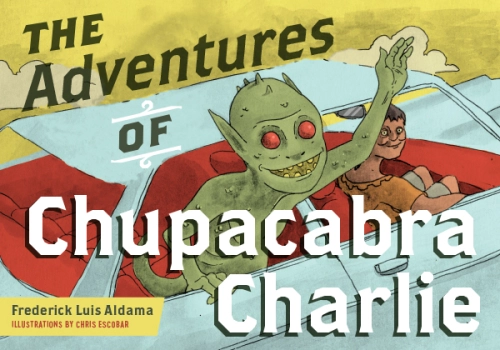
 ABOUT THE AUTHOR: Frederick Luis Aldama is Irish-Guatemalan and Mexican Latinx. His mamá was a bilingual elementary school teacher in California. As a kid, he couldn’t get enough of his abuelita’s stories of El Chupacabra, La Llorona, and El Cucuy. Today he is a Distinguished University Professor at The Ohio State University. He is the author, coauthor, editor, and coeditor of 36 books.
ABOUT THE AUTHOR: Frederick Luis Aldama is Irish-Guatemalan and Mexican Latinx. His mamá was a bilingual elementary school teacher in California. As a kid, he couldn’t get enough of his abuelita’s stories of El Chupacabra, La Llorona, and El Cucuy. Today he is a Distinguished University Professor at The Ohio State University. He is the author, coauthor, editor, and coeditor of 36 books. My Papi Has a Motorcycle, written by Isabel Quintero and illustrated by Zeke Peña, tells the story of young Daisy Ramona, a girl who eagerly awaits her Papi’s return home after a long day at work. When he arrives, Daisy Ramona and her Papi will take a ride through their city on the back of his motorcycle. Their ride takes us on a journey through their changing neighborhood, where we get a glimpse into the places and people that make her community so special. On their ride, Daisy and her Papi pass the local panadería where they buy conchas on Sunday mornings, the post office, and their abuelito’s yellow house (where the food always tastes better). They greet each person they meet with a nod of the head or a wave, letting readers see the closeness of this comunidad. Daisy’s ride with her Papi reminds us that although the world outside their home is changing, the love inside will always stay the same.
My Papi Has a Motorcycle, written by Isabel Quintero and illustrated by Zeke Peña, tells the story of young Daisy Ramona, a girl who eagerly awaits her Papi’s return home after a long day at work. When he arrives, Daisy Ramona and her Papi will take a ride through their city on the back of his motorcycle. Their ride takes us on a journey through their changing neighborhood, where we get a glimpse into the places and people that make her community so special. On their ride, Daisy and her Papi pass the local panadería where they buy conchas on Sunday mornings, the post office, and their abuelito’s yellow house (where the food always tastes better). They greet each person they meet with a nod of the head or a wave, letting readers see the closeness of this comunidad. Daisy’s ride with her Papi reminds us that although the world outside their home is changing, the love inside will always stay the same. Abuelita Full of Life/Llena de vida
Abuelita Full of Life/Llena de vida Tía Isa Wants a Car
Tía Isa Wants a Car In My Family/En mi familia
In My Family/En mi familia The Christmas Gift/El regalo de la navidad
The Christmas Gift/El regalo de la navidad Imagine
Imagine Planting Stories: The Life of Librarian and Storyteller Pura Belpré
Planting Stories: The Life of Librarian and Storyteller Pura Belpré Separate is Never Equal: Sylvia Mendez and Her Family’s Fight for Desegregation
Separate is Never Equal: Sylvia Mendez and Her Family’s Fight for Desegregation Tracey T. Flores is an assistant professor of language and literacy in the Department of Curriculum and Instruction at the University of Texas at Austin. She is a former English Language Development (ELD) and English language arts teacher, working for eight years in K-8 schools throughout Glendale and Phoenix, Arizona. Tracey is the founder of Somos Escritoras/We Are Writers (
Tracey T. Flores is an assistant professor of language and literacy in the Department of Curriculum and Instruction at the University of Texas at Austin. She is a former English Language Development (ELD) and English language arts teacher, working for eight years in K-8 schools throughout Glendale and Phoenix, Arizona. Tracey is the founder of Somos Escritoras/We Are Writers (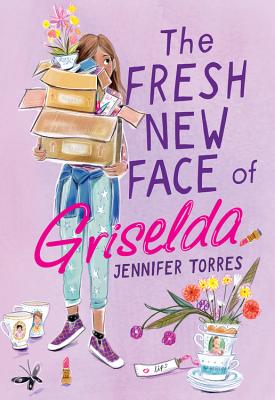 DESCRIPTION OF THE BOOK: Griselda “Geez” Zaragoza has a love for beautiful things, like her collection of vintage teacups and the flower garden she and her dad planted in the front yard. But when his business fails, Griselda loses not just her home, but also her confidence and her trust in her unflappable parents.
DESCRIPTION OF THE BOOK: Griselda “Geez” Zaragoza has a love for beautiful things, like her collection of vintage teacups and the flower garden she and her dad planted in the front yard. But when his business fails, Griselda loses not just her home, but also her confidence and her trust in her unflappable parents. ABOUT THE AUTHOR: Jennifer Torres is the author of Flor and Miranda Steal the Show, Stef Soto, Taco Queen, and Finding the Music/En Pos de la Música. A graduate of Northwestern University and the University of Westminster, London, her background is in journalism. She has worked for The Record newspaper in Stockton and now lives with her husband and two little girls in Southern California.
ABOUT THE AUTHOR: Jennifer Torres is the author of Flor and Miranda Steal the Show, Stef Soto, Taco Queen, and Finding the Music/En Pos de la Música. A graduate of Northwestern University and the University of Westminster, London, her background is in journalism. She has worked for The Record newspaper in Stockton and now lives with her husband and two little girls in Southern California. ABOUT THE REVIEWER: Clarissa Hadge is a Chicanx transplant from sunny Southern California who now lives in the less-than-sunny Northeast. A graduate of Simmons University, her background is in writing for children. An advocate for more inclusive literature for children and young adults, she is the bookstore manager and children’s book buyer at an independent bookstore in Boston and the current co-chair of the New England Children’s Booksellers Advisory Council (NECBA).
ABOUT THE REVIEWER: Clarissa Hadge is a Chicanx transplant from sunny Southern California who now lives in the less-than-sunny Northeast. A graduate of Simmons University, her background is in writing for children. An advocate for more inclusive literature for children and young adults, she is the bookstore manager and children’s book buyer at an independent bookstore in Boston and the current co-chair of the New England Children’s Booksellers Advisory Council (NECBA).